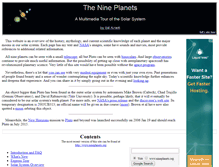 planets-water.com
planets-water.com
Air to Water - Water from Air - Home
Closed for business for now! Regretfully, we had to suspend our operations because of one of our own Sales team manager's rouge sales ethics resulting to transfer of funds and delivery issues to our existing customers' claims. Fortunately, we were in the process of merging with a world-wide brand to serve you with our latest products for a cheaper and better support. AND THE LEGAL NEWS:. All our known customers will be contacted directly by our Legal Team. All the existing orders are under investigation ...
 planets-world.com
planets-world.com
Sorry, your browser does not support frames. Please go here.
 planets.1-2-3problemsolved.com
planets.1-2-3problemsolved.com
The Planets, Mercury, Venus, Mars, Jupiter, Saturn, Uranus, Neptune & Pluto
THE STAR OF OUR SOLAR SYSTEM. Our solar system consists of an average star we know as the Sun, and nine (now eight because of Pluto) planets. The Sun is the strongest source of electromagnetic energy (mostly in the form of heat and light) in our solar system. The Sun's nearest known neighbor is a red dwarf star called Proxima Centauri, about 4.3 light years away. Earth, the third planet from the sun, orbits at a mean distance from the sun of 92,960,000 miles. that distance is also known as 1 Astronom...
 planets.agu.org
planets.agu.org
AGU Planetary Sciences Section
Exploring all things planetary. Article: Geology and NASA. Dr Ellen Stofan shares her early interest in planetary scientist, thoughts on future exploration, and what it's like being Chief Scientist at NASA. Read more. Welcome to New Worlds and Discoveries. AGU's Planetary Sciences Section encompasses basic research into the nature of planets and how they work, as well as the planning and implementation of space missions for exploration and discovery. Join us at one of many meetings and conferences. The A...
 planets.amqtech.com
planets.amqtech.com
Planets by AMQTech
An informational highway to the Solar System! Available now on the Google Play Store! Users can change the design of the app to make it feel like their own. Planets is designed with Google's Material Design concept. Planets is available on mobile phones, tablets, and supported Android TV devices. Information at your fingertips! Planets is loaded with information taken from three trusted sources, rewritten by hand and inserted into the app. Your app. Your rules. Red, Orange, Blue, Green, Purple, and Dark.
 planets.astronomy.net
planets.astronomy.net
The Nine Planets Solar System Tour
A Multimedia Tour of the Solar System. The New Solar System. Summarizes what we've learned from interplanetary explorations in the last 25 years. My primary reference for The Nine Planets. T Rex and the Crater of Doom. The story of the discovery of the impact crater that doomed the dinosaurs. Nice description of how science works in the real world. Encyclopedia of the Solar System. A more scholarly introduction to planetary science for those who want to dig a little deeper. Build Your Own Telescope.
 planets.bandcamp.com
planets.bandcamp.com
Music | planets
Or browse results titled. 1 & (pageBandParentLabel() pageLabel() , col1: columns() = = 1, col2: columns() = = 2, col3: columns() = = 3 } ". 0 }" Other Linked Artists/Labels. Edit artists. add more artists. Please verify your email by clicking the link we sent to . Change email / Send again. MAYBE WE WANT MORE INSECTS. Brandenburger Theater, Studiobühne. Switch to mobile view.
 planets.biz
planets.biz
planets.biz
The owner of planets.biz. Is offering it for sale for an asking price of 3500 USD! This page provided to the domain owner free. By Sedo's Domain Parking. Disclaimer: Domain owner and Sedo maintain no relationship with third party advertisers. Reference to any specific service or trade mark is not controlled by Sedo or domain owner and does not constitute or imply its association, endorsement or recommendation.
 planets.co.uk
planets.co.uk
Planets and Solar Systems | Celebrating the planets of our solar system
Planets and Solar Systems. Celebrating the planets of our solar system. Skip to primary content. Skip to secondary content. July 16, 2011. What makes a planet? March 16, 2011. A planet as defined by the International Astronomical Union (IAU), is a celestial body orbiting a star or stellar remnant that is massive enough to be rounded by its own gravity, is not massive enough to cause thermonuclear fusion, and has cleared its neighbouring region of planetesimals. Even now there is no uncontested definition...
 planets.com
planets.com
planets.com
The Sponsored Listings displayed above are served automatically by a third party. Neither the service provider nor the domain owner maintain any relationship with the advertisers. In case of trademark issues please contact the domain owner directly (contact information can be found in whois).
 planets.consulintel.es
planets.consulintel.es
Planets - Inicio
PlaNetS es un proyecto que pertenece al cluster europeo EUREKA/MEDEA y que es co-financiado por el Ministerio de Industia, Turismo y Comercio dentro del Plan Nacional de Investigación Científica, Desarrollo e Innovación Tecnológica 2004-2007. PlaNetS es un proyecto que pertenece al cluster europeo EUREKA/MEDEA que pretende servir de marco adecuado para abordar la evolución de los siguientes aspectos tecnológicos relacionados con las redes de acceso:. Tu IPv4 es (66.160.134.62).





